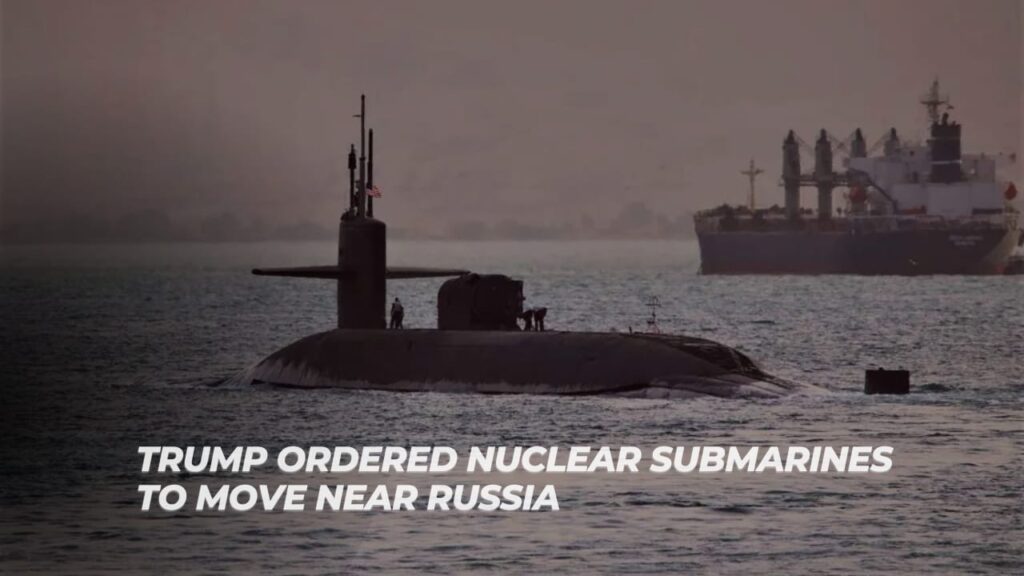In a dramatic heightening of geopolitical tensions, former U.S. President Donald Trump confirmed through Truth Social that he has directed two American nuclear submarines to sail close to Russian territorial seas. The move comes following extremely controversial nuclear threats made by former Russian President Dmitry Medvedev, who recently indicated Moscow might supply nuclear warheads to Iran.
Trump described the Russian statement as “foolish and inflammatory” and threatened severe repercussions if the threats were anything beyond verbal.
“Based on the highly provocative statements of the Former President of Russia, Dmitry Medvedev, who is now the Deputy Chairman of the Security Council of the Russian Federation, I have ordered two Nuclear Submarines to be positioned in the appropriate regions, just in case these foolish and inflammatory statements are more than just that. Words are very important, and can often lead to unintended consequences, I hope this will not be one of those instances. Thank you for your attention to this matter!,” Trump wrote.
The Trigger: Medvedev’s Threat on Iran
The row started when Dmitry Medvedev suggested that Russia might supply nuclear weapons to Iran in case Western countries continued to equip Ukraine with weapons and pressure Moscow in the Middle East. This was in response to U.S. and Israeli airstrikes against suspected Iranian nuclear sites.
If the United States and its partners persist in this direction, we cannot exclude the likelihood that Iran could receive everything it needs to protect itself,” Medvedev supposedly said.
These comments have caused global concern, especially from nuclear monitors and Middle East commentators.
Why Nuclear Submarines?
The U.S. triad of nuclear power comprises land-based ICBMs, strategic bombers, and ballistic missile submarines (SSBNs). The Ohio-class submarines deployed here are stealthy and can fire nuclear payloads from any point in the globe.
Most Important Reasons for Deployment:
Strategic deterrence: Submarines can attack back even if land-based forces are destroyed.
Stealth and survivability: Practically impossible to detect, providing the U.S. with second-strike capability.
Political signaling: A means of demonstrating power without breaking international norms.
“The placement of these submarines is a deliberate move — not towards war, but towards preventing one,” retired U.S. Navy Rear Admiral John Kirby said.
Global Response
Russian officials have yet to make a formal statement, but state media such as RT and Sputnik have labeled the action “reckless” and “provocative,” presenting it as a last-ditch effort by Trump to show relevance amidst an election cycle.
EU leaders are urging restraint, with diplomatic solutions being prioritized over escalation. French President Élisabeth Borne called on both countries to “avoid unnecessary military gestures.
Israeli officials applauded Trump’s aggressive stance, especially when Iranian nuclear sites were hit in coordinated attacks. Saudi Arabia and the UAE also embraced greater U.S. profile in the region.
Expert Analysis: Cold War 2.0?
Numerous analysts claim this is the most visible U.S. nuclear signaling since the Cuban Missile Crisis.
“We are witnessing the return of Cold War-style brinkmanship,” said Dr. Fiona Hill, former White House Russia advisor.
But unlike in the past, today’s multipolar world is much more volatile.”
(Source: New Republic)
Political Implications?
Trump’s return to the campaign trail in 2026 has been seen by many observers as serving both strategic and electoral goals. It reasserts his “America First” military position and positions him as a hard-nosed leader not willing to accept nuclear blackmail.
But critics say making the nuclear submarine’s travel schedule public typically a secret jeopardizes U.S. military confidentiality and might enhance the likelihood of miscalculation.

